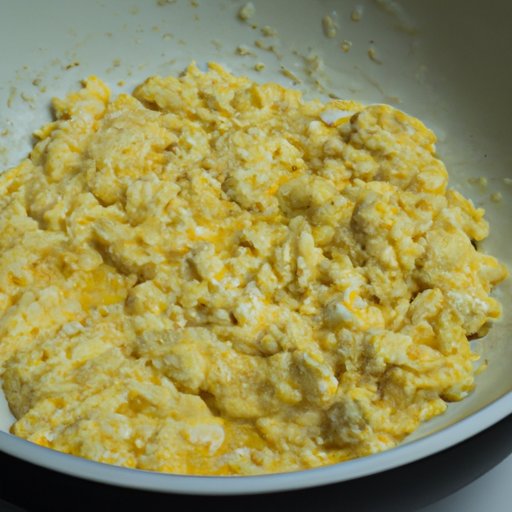
Introduction
Scrambled eggs are a popular choice for breakfast or brunch, but what to do when there are leftovers? Can you reheat them without sacrificing their taste and texture? Many people face this common problem and end up either wasting perfectly good food or eating reheated scrambled eggs that are dry, rubbery or even potentially dangerous. In this article, we’ll explore the do’s and don’ts of reheating scrambled eggs, provide a guide to safely reheating them, answer some common questions and share creative ideas for repurposing leftover scrambled eggs.
The Do’s and Don’ts of Reheating Scrambled Eggs
Before we dive into the process of reheating scrambled eggs, it’s important to know what to avoid. One of the biggest mistakes people make is using the microwave. While it may be quick and convenient, microwaving can quickly turn scrambled eggs into a dry, rubbery mess due to the uneven and high heat. Additionally, using high heat on the stovetop can result in the same undesirable outcomes. Here are some dos and don’ts to keep in mind when reheating scrambled eggs:
- Do use a non-stick pan or skillet
- Do use low heat
- Don’t use the microwave
- Don’t use high heat
A Guide to Safely Reheating Scrambled Eggs
Now that we know what to avoid, let’s explore a step-by-step guide to safely reheating scrambled eggs:
- Remove the leftover scrambled eggs from the fridge and let them sit at room temperature for about 10-15 minutes to take the chill off.
- Prepare a non-stick pan or skillet and heat it up on low heat.
- Add a small amount of milk or cream to the scrambled eggs to help retain their moisture and prevent them from drying out during the reheating process.
- Place the scrambled eggs in the pan and stir gently until they are heated through.
Some additional tips to keep in mind while reheating scrambled eggs include using a lid to help them cook evenly and prevent drying out, and stirring occasionally to avoid overcooking and sticking to the pan. Adding a bit of cheese, herbs or other seasonings can also enhance the flavor of the reheated eggs.
Is It Safe to Reheat Scrambled Eggs? Here’s What You Need To Know
As with any food, safety concerns should always be taken into consideration when reheating scrambled eggs. The risk of bacterial growth is a valid concern, especially if the eggs have been left at room temperature for too long or improperly stored. To avoid food poisoning, it’s important to store scrambled eggs in the fridge immediately after cooking, and consume them within 3-4 days.
When reheating scrambled eggs, it’s best to do so at a temperature of 165°F. Using a thermometer can help ensure that the eggs reach this temperature and are safe to eat. Additionally, it’s important to avoid reheating scrambled eggs more than once, as this can increase the risk of bacterial growth.
The Best Methods for Reheating Scrambled Eggs Without Losing Their Flavor
If you’re looking for ways to reheat scrambled eggs without sacrificing their texture and flavor, you have a few options:
- Reheat in a double boiler or bain-marie to gently warm the eggs without overcooking them.
- Reheat in the oven by placing the eggs in a greased baking dish or muffin tin and heating at 350°F for 10-15 minutes.
Adding toppings like avocado, salsa or hot sauce can also add some extra flavor to your reheated eggs.
How Long Can You Keep Scrambled Eggs in the Fridge? And Other Questions Answered
Storing scrambled eggs properly can help prolong their freshness and prevent food waste. Here are some answers to common questions:
- How long can you keep scrambled eggs in the fridge? Scrambled eggs can be stored in an airtight container in the fridge for up to 3-4 days.
- Can you freeze scrambled eggs? Yes, scrambled eggs can be frozen for up to 6 months. However, they may lose some texture and flavor when thawed.
- Can you reheat frozen scrambled eggs? Yes, you can reheat scrambled eggs that have been previously frozen, following the same guidelines as reheating refrigerated scrambled eggs.
The Importance of Properly Storing and Reheating Scrambled Eggs
Properly storing and reheating scrambled eggs is not only important for safety reasons, but also for maintaining their freshness and flavor. By following the tips and guidelines outlined above, you can ensure a healthy and delicious meal that doesn’t go to waste.
Creative Ideas for Repurposing Leftover Scrambled Eggs (Hint: Reheating is Key)
If you’re tired of simply reheating leftover scrambled eggs for another breakfast, why not try repurposing them? Here are some creative ideas:
- Make breakfast burritos by wrapping scrambled eggs, cheese, veggies and salsa in a tortilla and reheating in the oven or microwave.
- Create a frittata by adding leftover scrambled eggs to a baking dish with veggies or meats, baking at 350°F for about 25-30 minutes.
- Add scrambled eggs to soups or stews to make them heartier and more filling.
- Make a breakfast sandwich by reheating scrambled eggs and adding them to a toasted English muffin with cheese, bacon or veggies.
Remember, reheating leftover scrambled eggs is key to making these creative dishes and avoiding food waste. Just be sure to follow safe reheating guidelines to prevent foodborne illness.
Conclusion
Reheating scrambled eggs is a common dilemma, but it doesn’t have to be a hassle. By following the dos and don’ts, safely reheating them, and storing them correctly, you can have a healthy and delicious meal with minimal effort. Additionally, repurposing leftover scrambled eggs can be a creative way to enhance your meals and avoid wastage. We hope this comprehensive guide has been helpful, and encourage you to try some of the tips and ideas shared in this article.




